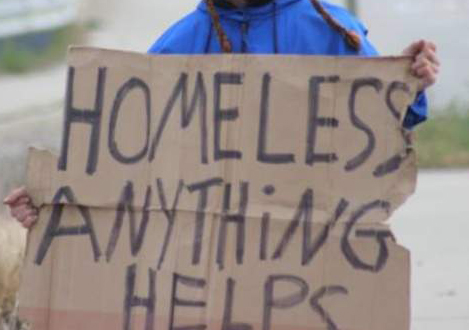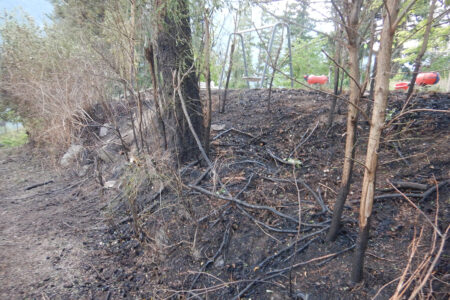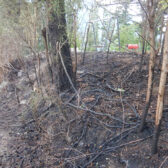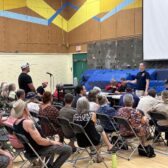Council swayed by evidence of merit for establishment of ‘Panhandling Bylaw’ and passes third reading
Strong evidence from police and city staff convinced the majority of council to move ahead with third reading of a proposed Panhandling Bylaw for Nelson.
With a city staff report already in hand, city council quizzed Nelson Police Department chief constable Paul Burkart Monday night in its regular council meeting on the merit of advancing a Nelson specific piece of municipal legislation, versus the existing Safe Streets Act, which applies to all communities in the province (including Nelson) and is enforced by police.
Several councilors asked Burkart about the need to have a Panhandling Bylaw when there was provincial legislation in the form of the Safe Streets Act to deal with a panhandling problem.
But a Nelson-specific bylaw would allow police and bylaw officers to safely deal with the proliferation of downtown panhandlers, provide education and apply some guidelines, Burkart noted, not bring about the eradication of panhandling altogether and make panhandlers into criminals.
“The bylaw would be a safe medium where we can deal with someone without charging them,” he said.
In 2015, 24 police files were created under the Safe Streets Act; 21 of those were warnings, two resulted in tickets and one a criminal charge.
Most matters involving panhandling would be more appropriately addressed in a bylaw enforcement scheme due to the primarily non-serious nature of the incidents, Burkart explained, while retaining the ability to escalate more serious matters through the court system using the Safe Streets Act.
“I think using police is heavy handed and we need to reduce the load on our police force,” said Coun. Michael Dailly, “but if bylaw can handle the work, then I am” all for this.”
The provincial act and the police force are not part of the solution to dealing with the panhandling problem, echoed Mayor Deb Kozak.
“I don’t think the Safe Streets Act is the best possible tool to use for this because it criminalizes people and I don’t think criminalizing is the answer,” she said.
Council later passed third reading on the Panhandling Bylaw, setting it up for one final debate next month for fourth reading and adoption, as well as directing city staff to develop a Bylaw Enforcement Policy relevant to enforcement of the Panhandling Bylaw.
Although there had been some reference from the public to the proposed bylaw criminalizing panhandling when it was first introduced, council does not have the authority to criminalize; that is a federal authority.
Council does have authority to regulate public spaces (Section 8 of the Community Charter) and the Safe Streets Act does govern what happens on Nelson streets. The following are prohibited by both the proposed Panhandling Bylaw and the Safe Streets Act:
- Obstructing the passage of pedestrians;
- Touching a person;
- Continuing to approach a person who has provided a negative response;
- Approaching a person in a group of two or more;
- Panhandling in a manner which obstructs flow of traffic;
- Panhandling occupants of motor vehicles that are parked, stopped at a traffic light or loading/unloading;
- Cannot panhandle within five metres of an ATM, pay telephone, public washroom.
City staff recommended a bylaw to provide authority to bylaw enforcement officers to regulate panhandling matters, with sections that include the use of the restorative justice program. But Coun. Robin Cherbo thought the bylaw proposition was a “negative approach” to the problem.
“I think this is like trying to herd cats,” he said. “I don’t think it’s going to do what we want it to do.”
Coun. Anna Purcell agreed, adding that the proposed bylaw was a divisive issue in the community.
“My strong preference is to put this off for another year and a half,” she said, citing the need for time for the Street Culture Collaborative Initiative to put some of its measures into place.
In addition to the Safe Streets Act, the city’s proposed Panhandling Bylaw prohibits:
- Panhandling within five m. of a financial institution, bus stop, bus shelter, liquor store, movie theatre, sidewalk café, place of worship entrance;
- Panhandling after sunset;
- Impeding access/egress from a business;
- Panhandling from persons seated at a sidewalk café.
“The goal is to change behavior, not to punish, and we thought that (the bylaw) was an avenue for that,” city manager Kevin Cormack told council.
The city’s enforcement policy regarding the bylaw is expected to be in place before the passing of the final motin, and city council will get the opportunity to review it before it votes.
The Safe Streets Act provides authority for a “peace officer” (as defined in the Interpretation Act) to act if they believe an offence has been committed under the Act.
However, city staff advised council that city bylaw enforcement offices did not meet the definition of a peace officer under the Interpretation Act.
“The Safe Streets Act provides that a peace officer may arrest persons committing an offence under the Act, but city bylaw enforcement officers do not have the power of arrest,” read a city staff report to council. “Therefore, enactment of a bylaw is required to provide authority to bylaw enforcement officers to regulate panhandling matters.”
Coun. Dailly asked if bylaw officers were able to handle the additional responsibility. Burkart said the officers would undergo further training to be able to do the job more “judiciously.”
The panhandling plot thickens
Additional information has been gathered by city staff since that time which includes:
- At the February 2016 committee of the whole meeting, a gentleman who has been busking in Nelson for the last 12 years spoke of the challenges he faced as a busker with the increased volume and aggressiveness of panhandling on the city streets. The gentlemen expressed his concerns that he (as well as the panhandlers) made his living working on the streets and that there were rules buskers must work within. He felt it was unfair that rules were not equally applicable to people that were panhandling.
- Comment has been received from the business community expressing concerns about safety in the downtown core and the increasing volume and aggressiveness of panhandling.
- The Street Culture Collaborative Initiative was presented to council at the March committee of the whole meeting. “As this initiative continues to evolve, it will provide council with alternative options to address the city’s street culture that can work in concert with the city’s regulatory scheme,” a city staff report read.
- Issuing penalties to persons who may be at the poverty line does not make common sense. City staff held discussions with the restorative justice coordinator who feels that restorative justice is a good tool that can used in dealing with panhandling offences.
In order for restorative justice to apply, an offence must first be recognized (in this case a bylaw offence rather than a criminal offence).
“It should be noted that provincial legislation restricts bylaw offence mechanisms to swearing of information (court proceedings), municipal information tickets and bylaw enforcement notices; these are the tools that must be used in the regulatory scheme,” read a city staff report.
Council can however, provide direction to staff as to how they would like a particular bylaw to be enforced through policy.
The road to today
The Panhandling Bylaw was introduced in September and it ignited controversy.
Council approved first and second reading only, directing staff to further review and revise the bylaw accordingly. The bylaw was placed in front of council at the Oct. 5 regular meeting for third reading where the bylaw was referred back to staff for further community consultation.
The results of the community consultation were provided to council at the Oct. 26 committee of the whole meeting and were summarized in a report to council at the Nov. 2 regular meeting where third reading of the bylaw was postponed to a spring 2016 meeting providing opportunity for staff to gather further information.
The bylaw was presented for third reading on May 2.



























